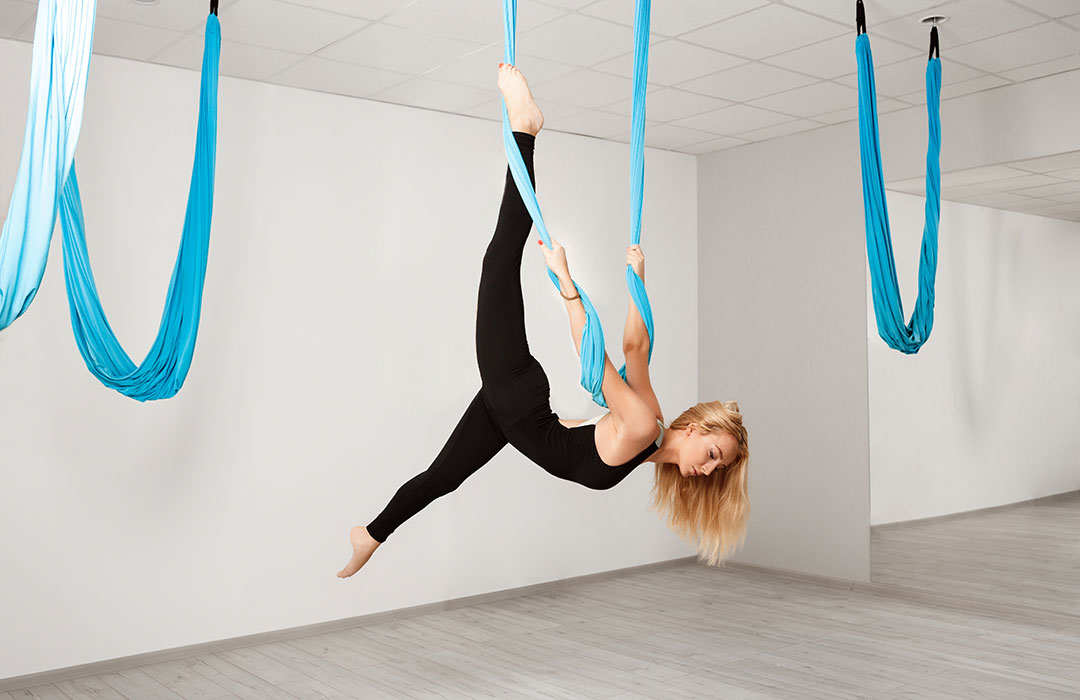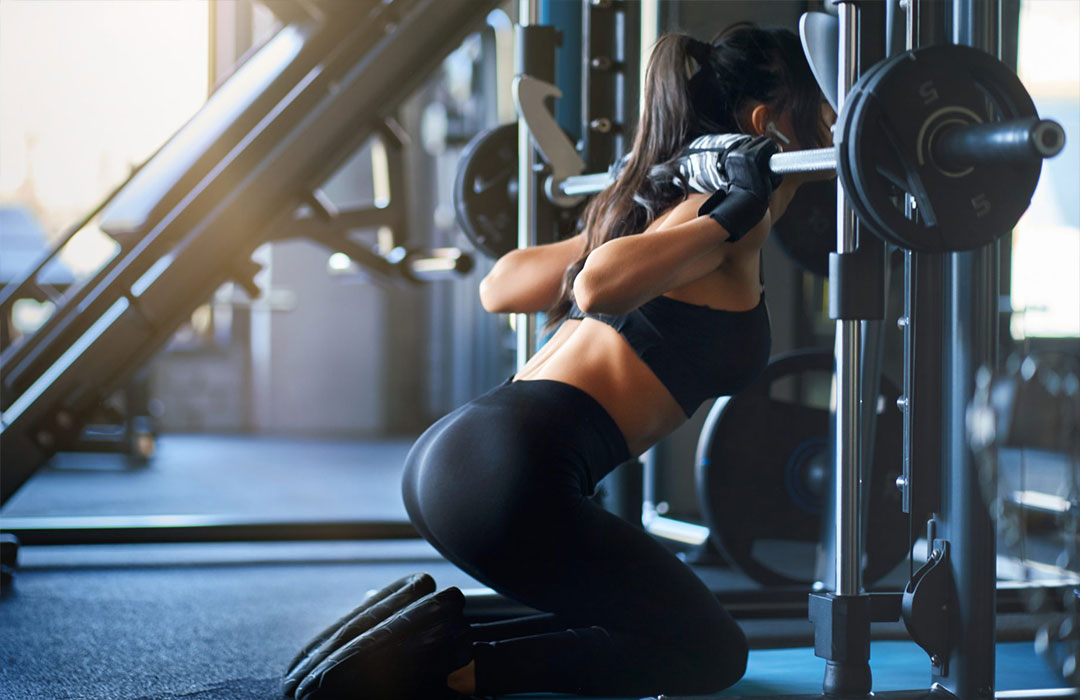Introduction: Experience the Joy of Aerial Yoga
Aerial Yoga is a unique and exhilarating form of exercise that has gained popularity in recent years. It combines traditional yoga poses with a hammock or silk fabric suspended from the ceiling. This fusion of Yoga, pilates, and aerial arts creates a workout that challenges your body and brings joy and playfulness to your fitness routine. In this article, we will explore the many benefits of aerial Yoga, from toning and flexibility to stress relief and mindfulness.
What is Aerial Yoga?
Introduction to Aerial Yoga
Aerial Yoga, or anti-gravity or flying Yoga, is a unique fitness practice combining elements of traditional Yoga, pilates, and aerial arts. It involves performing yoga poses and exercises while suspended from a hammock or silk fabric. The hammock provides support and allows for a more fantastic range of motion, making aerial Yoga an excellent choice for people of all fitness levels.
How Aerial Yoga Works
The fabric or hammock is securely attached to the ceiling during an aerial yoga session, forming a solid and stable anchor point. Practitioners use the hammock to support their body weight and perform various yoga poses, flips, inversions and stretches. The hammock allows deeper spaces, spine decompression, and increased stability during challenging poses.
History of Aerial Yoga
Aerial Yoga has its roots in traditional Yoga and the circus arts. Aerial performer Christopher Harrison first introduced it in the early 2000s. Drawing inspiration from his background in gymnastics, dance, and Yoga, Harrison developed a system that combined the grace and fluidity of aerial arts with the mindful practice of Yoga. Since then, aerial Yoga has evolved and gained popularity worldwide.
Benefits of Aerial Yoga
Aerial Yoga offers numerous benefits for both the body and mind. Explore some key advantages of incorporating aerial Yoga into your fitness routine.
Toning and Strengthening
Aerial Yoga engages multiple muscle groups simultaneously, resulting in a full-body workout. The instability of the hammock requires you to activate your core muscles constantly, leading to improved strength and toning. Additionally, aerial Yoga’s various poses and transitions target specific muscle groups, helping sculpt and define your body.
Improved Flexibility
The hammock in aerial Yoga acts as a supportive prop, allowing you to deepen your stretches and explore a more excellent range of motion. Regular practice can help improve flexibility, joint mobility, and posture. The gentle traction provided by the hammock also helps release tension and tightness in the muscles, leading to increased flexibility over time.
Stress Relief and Mindfulness
Aerial Yoga offers a unique opportunity to disconnect from the stresses of daily life and focus on the present moment. The flowing movements, deep breathing, and gentle swings create a meditative and calming experience. This mindful practice helps reduce stress, promote relaxation, and improve overall mental well-being.
Rehabilitation and Injury Prevention
The low-impact nature of aerial Yoga makes it suitable for recovering from injuries or joint-related issues. The controlled movements and supported inversions can help decompress the spine, relieve joint pressure, and improve circulation. Aerial Yoga also aids in building core strength, which is essential for maintaining a healthy back and preventing injuries.
Core and Balance Enhancement
Aerial yoga poses require constant engagement of the core muscles to maintain stability and control. This strengthens the deep abdominal muscles, improving overall core strength and stability. Balancing on the hammock also challenges proprioception, enhancing your body’s spatial awareness and balance skills.
Getting Started with Aerial Yoga
Finding an Aerial Yoga Studio
Finding a reputable aerial yoga studio in your area is the best to begin your aerial yoga journey. Look for certified instructors who have undergone proper training and can guide you safely through the practice. Joining a studio will provide you with a supportive community and access to specialized equipment.
Necessary Equipment
When attending an aerial yoga class, the studio typically provides the necessary equipment, including hammocks or silk fabrics. However, you can purchase your aerial yoga hammock or rigging equipment if you prefer practicing at home. Ensure that the equipment is high quality and designed specifically for aerial Yoga.
Safety Considerations
As with any physical activity, safety should be a priority in aerial Yoga. Listen to your body and avoid pushing beyond your limits. Always follow your instructor’s instructions, especially when attempting inversions or more advanced poses. It’s also essential to properly warm up before each session to prevent injuries.
Beginner-Friendly Poses and Exercises
If you’re new to aerial Yoga, start with beginner-friendly poses to gradually build strength and confidence. Some common introductory poses include the “Aerial Mountain Pose,” “Flying Child’s Pose,” and “Aerial Downward Dog.” These poses focus on basic alignment and allow you to familiarize yourself with the hammock and its movements.
Advanced Aerial Yoga Techniques
Intermediate and Advanced Poses
Once you have mastered the foundational poses, you can progress to more intermediate and advanced aerial yoga techniques. These poses challenge your strength, flexibility, and balance even further. Examples of intermediate poses include the “Aerial Warrior,” “Aerial Dancer Pose,” and “Aerial Plank.” Advanced poses like the “Aerial Inverted Cross” and “Aerial Handstand” require advanced strength and control.
Progressing in Aerial Yoga
Advancing in aerial Yoga is a gradual process that requires consistency and patience. Regular practice will gradually build your strength, flexibility, and confidence. As you become more comfortable with the hammock and the poses, you can experiment with transitions, flows, and creative sequences to express your style.
Combining Aerial Yoga with Other Exercises
Aerial Yoga can be a great complement to other forms of exercise. You can integrate it into your fitness routine with strength training, cardio, or dance. This fusion allows you to reap the benefits of both practices while adding variety and excitement to your workouts.
Aerial Yoga for Specific Fitness Goals
Weight Loss and Body Toning
If your goal is weight loss and body toning, aerial Yoga can be an excellent choice. Combining strength-building exercises, cardiovascular conditioning, and increased flexibility can help you burn calories and sculpt lean muscles. Regular practice and a balanced diet can contribute to achieving your weight loss goals.
Increasing Flexibility and Range of Motion
Aerial Yoga’s unique approach to stretching and deepening poses can significantly improve your flexibility and range of motion. The hammock provides support, allowing you to explore deeper stretches and release tension in the muscles safely. Consistent practice can help you achieve greater flexibility in various body areas.
Stress Reduction and Mental Well-being
One of the primary benefits of aerial Yoga is its ability to promote relaxation and reduce stress levels. The mindful nature of the practice, combined with gentle swinging and deep breathing, helps calm the mind and soothe the nervous system. Regular participation in aerial Yoga can enhance your overall mental well-being and contribute to a more balanced and positive outlook on life.
5.4 Enhancing Athletic Performance
Aerial Yoga’s focus on core strength, balance, and flexibility makes it an excellent addition to an athlete’s training regimen. The unique movements and poses in aerial Yoga challenge the body in new ways, improving overall body control, coordination, and proprioception. Athletes from various disciplines, such as gymnastics, dance, and martial arts, can benefit from incorporating aerial Yoga into their routines.
FAQs
-
How often should I practice aerial Yoga?
To experience the maximum benefits of aerial Yoga, it’s recommended to practice at least 2-3 times per week. Consistency is key to building strength, flexibility, and body awareness. However, always listen to your body and allow rest days to prevent overexertion.
-
Is aerial Yoga suitable for beginners?
Yes, aerial Yoga is suitable for beginners. Many studios offer beginner-friendly classes that introduce basic poses and movements. Certified instructors provide guidance and modifications to ensure safety and progress at a comfortable pace.
-
What if I’m afraid of heights?
Aerial Yoga can be an opportunity to overcome a fear of heights in a controlled and supportive environment. The hammock provides security and lets you gradually acclimate to being off the ground. Communicate your anxiety to your instructor; they can help guide you with patience and understanding.
-
Can aerial yoga help with back pain?
Aerial Yoga can be beneficial for individuals with back pain. The gentle traction and decompression of the spine in certain poses can help alleviate pressure and tension. However, it’s essential to consult with a healthcare professional or a qualified instructor who can provide appropriate modifications and guidance based on your specific condition.
-
Can children and seniors practice aerial Yoga?
Aerial Yoga can be practiced by children and seniors with appropriate modifications and under the guidance of a qualified instructor. Children can benefit from aerial Yoga’s playful and engaging nature, which enhances their coordination, body awareness, and self-confidence. For seniors, aerial Yoga offers a gentle and low-impact exercise option that can help maintain flexibility, strength, and balance.
-
Is aerial Yoga a good option during pregnancy?
Aerial Yoga is generally not recommended during pregnancy, as it involves inversions and movements that may strain the abdomen and pelvic area. It’s crucial to prioritize the safety of the mother and the baby during this particular time. However, prenatal yoga classes can provide a safe and effective alternative for pregnant women.
Conclusion
Aerial Yoga is more than just a workout; it’s a holistic practice that nurtures both the body and the mind. Through a combination of Yoga, pilates, and aerial arts, it offers a unique and transformative fitness experience. Whether you want to tone your body, increase flexibility, reduce stress, or enhance your overall well-being, aerial Yoga can be the perfect addition to your fitness routine. So, why not try it and soar to new heights of fitness and self-discovery?




